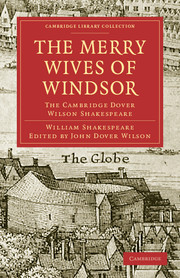THE STAGE-HISTORY
Published online by Cambridge University Press: 07 September 2010
Summary
The Merry Wives of Windsor has always been popular in the theatre. The quarto edition of 1602 states that it had already ‘bene diuers times Acted by the right Honorable my Lord Chamberlaines seruants. Both before her Maiestie, and else-where.’ The Revels Accounts show that it was acted at Whitehall on the Sunday following Hallowmas Day (i.e. on November 1), 1604. An old MS printed in George R. Wright's Archaeologic and Historic Fragments, 1887, informs us that ‘the mery wifes of Winsor’ was acted before Charles I and Henrietta Maria by the Lady Elizabeth's servants (the Queen of Bohemia's Players) at the Cockpit on November 15, 1638. Pepys saw it at ‘the new Theatre’ (Killigrew's theatre) on December 5, 1660, when he liked the humours of the country gentleman (Slender, possibly acted by Wintershal) and the French doctor, but found ‘the rest but very poorly, and Sir J. Falstaffe [Cartwright] as bad as any’; again at the King's house on September 25, 1661, when he found it ‘ill done’—perhaps because he went ‘much against my nature and will, yet such is the power of the Devil over me I could not refuse it’; and a third time, at the King's house, on August 15, 1667, when ‘it did not please me at all, in no part of it.’ Downes, in his Roscius Anglicanus, includes this play among those which the King's Company acted ‘but now and then,’ not among their principal stock plays.
- Type
- Chapter
- Information
- The Merry Wives of WindsorThe Cambridge Dover Wilson Shakespeare, pp. 135 - 138Publisher: Cambridge University PressPrint publication year: 2009First published in: 1921



